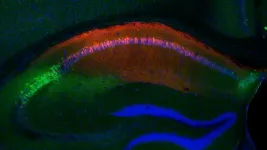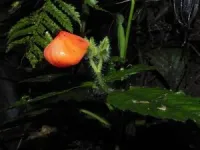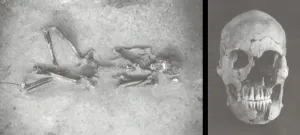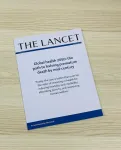(Press-News.org) NEW YORK, NY — How do we distinguish threat from safety? It’s a question important not just in our daily lives, but for human disorders linked with fear of others, such as social anxiety or post-traumatic stress disorder (PTSD). The microscope image accompanying this press release, from the laboratory of Steven A. Siegelbaum, PhD, at Columbia’s Zuckerman Institute, displays a powerful technique scientists used to help us find an answer.
The scientists were investigating the hippocampus, a brain area that plays a key role in memory in humans and mice. Specifically, they focused on the CA2 region, which is significant for social memory, the ability to remember other individuals, and the CA1 region, which is important for remembering places.
In this new study, the researchers for the first time reveal that CA1 and CA2 respectively encode the locations and individuals linked with a threatening experience. The results show that, beyond simply recognizing individuals, CA2 helps record more complex aspects of social memory: in this case, whether another individual is safe or risky. The scientists published their findings on October 15 in the journal Nature Neuroscience.
"It's vital to all species that live in social communities, including mice and humans, to have social memories that can help one avoid future experiences with others that might prove harmful while keeping ourselves open to individuals who may be beneficial," said Pegah Kassraian, PhD, a postdoctoral research fellow in the Siegelbaum lab and lead author of the new study. "Fearful memories are important for survival and help to keep us safe."
To investigate where fearful social memories originate in the brain, Dr. Kassraian and her colleagues gave individual mice a choice. They could scamper to one place, meet another mouse that was unknown to them, and receive a mild foot shock (much like a static electricity zap people might get after walking on a carpet and touching a doorknob). Scurrying in the opposite direction to meet a different stranger was safe. Normally, the mice quickly learned to avoid the strangers and locations that were associated with the shocks, and these memories lasted for at least 24 hours.
To determine where in the hippocampus these memories were stored, the researchers genetically altered the mice to enable them to selectively suppress the CA1 or CA2 regions. Surprisingly, turning off each region had very different effects. When the scientists silenced CA1, the mice could no longer remember where they were zapped, but they could still remember which stranger was associated with the threat. When they silenced CA2, the mice remembered where they were shocked, but became indiscriminately afraid of both strangers they met.
These new findings reveal that CA2 helps mice remember whether past encounters with others were threatening or safe. The results also are consistent with prior research detailing how CA1 is home to place cells, which encode locations.
Previous research has implicated CA2 in various neuropsychiatric conditions such as schizophrenia and autism. The new study suggests that further investigating CA2 might help scientists better understand social anxiety, post-traumatic stress disorder and other conditions that can lead to social withdrawal.
"It's possible that social withdrawal symptoms are related to an inability to discriminate between who is a threat and who is not," said Dr. Siegelbaum, who is also a professor and chair of the department of neuroscience at Columbia’s Vagelos College of Physicians and Surgeons. "Targeting CA2 could be a useful way of diagnosing or treating disorders linked with a fear of others.”
###
The paper, “The hippocampal CA2 region discriminates social threat from social safety,” was published online in Nature Neuroscience on October 15, 2024.
The full list of authors includes Pegah Kassraian, Shivani K. Bigler, Diana M. Gilly, Neilesh Shrotri, Anastasia Barnett, Heon-Jin Lee, W. Scott Young, and Steven A. Siegelbaum.
The authors report no conflicts of interest.
END
In a new study published in Nature Communications Biology, wildlife rangers from the Uganda Wildlife Authority have demonstrated their ability to generate precise and reliable data on lion populations in Uganda’s Nile Delta, a critical stronghold for African lions.
The study reveals that wildlife rangers, a critical component of global conservation efforts but often underutilised in scientific research, can play a pivotal role in the conservation science surrounding the world’s most beloved big cat.
Rangers are effective at monitoring lions and are an underutilised resource
The study showed rangers ...
One of the most notorious mass extinction events in modern times occurred on a hilltop in coastal Ecuador in the 1980s. Ninety species of plants known from nowhere else on Earth—many of them new to science and not yet given a name—went extinct when the last cloud forests of the Centinela range were cleared for agriculture. The cautionary tale of Centinela has long been a driving force in the fight to save the world’s rainforests. But did it really happen?
In a new study published in Nature Plants, an international team of botanists reveals that, indeed, it did not happen. The researchers – who spent years of scouring natural history museums, biodiversity databases, ...
About The Study: Among individuals with ulcerative colitis, the allele HLA-DRB1*01:03 was associated with severe ulcerative colitis requiring major operation, hospitalization, and systemic corticosteroid use compared with less severe disease. HLA-DRB1*01:03 has previously been linked to ulcerative colitis incidence. This study supports earlier, targeted genetic studies comparing patients with healthy controls reporting an association with total disease and severe disease requiring colectomy.
Corresponding Author: To contact the corresponding author, Marie Vibeke Vestergaard, MSc, email marievv@dcm.aau.dk.
To access the embargoed study: Visit our ...
Montpellier, France – 15 October 2024. In a captivating Genomic Press Interview published on October 15, 2024, in the peer-reviewed journal Genomic Psychiatry (Genomic Press), Professor Philippe Courtet shares groundbreaking perspectives on suicide prevention and mental health care. As an influential PU-PH (Professeur des Universités-Praticien Hospitalier), he is a Professor of Psychiatry at the University of Montpellier, France, and head of emergency psychiatry at the University Hospital of, Professor Courtet stands at the forefront of ...
Miscarriage, or early pregnancy loss, can have devastating emotional effects, but it is poorly managed in Canada. A review published in CMAJ (Canadian Medical Association Journal) https://www.cmaj.ca/lookup/doi/10.1503/cmaj.231489 provides guidance to physicians on how to diagnose and manage this condition and calls for referral to outpatient early pregnancy assessment clinics (EPACs) as well as a compassionate approach.
October 15 is Pregnancy and Infant Loss Remembrance Day.
Data suggest that 15%–20% of all confirmed pregnancies result in miscarriage, with ...
A joint research group led by Jonghyun Kim and Jun Ohashi of the University of Tokyo has demonstrated that the majority of immigration to the Japanese Archipelago in the Yayoi and Kofun periods (between 3000 BCE and 538 CE) came from the Korean Peninsula. The researchers analyzed the complete genome of a “Yayoi” individual and found that, among the non-Japanese populations, the results bore the most similarity to Korean populations. Although it is widely accepted that modern Japanese populations have a dual ancestry, the discovery provides insight into the details of immigration patterns to the ...
DURHAM, N.C. -- Since 1970, 37 countries have cut the probability of their citizens dying before they reach age 70 in half, a milestone that signals the remarkable progress many countries have made in preventing and treating disease. But a new report argues that this goal isn’t out of reach for any country that chooses to cut its premature mortality, even those afflicted by war or poverty.
The report, published Oct. 14 by The Lancet Commission on Investing in Health, lays out a roadmap for every nation that chooses to do so to cut ...
A team of 50 leading international experts, the Lancet Commission on Investing in Health (CIH), explored this question, resulting in clear, actionable, and achievable measures for achieving this ambitious goal worldwide. Six of the 50 commission members are affiliated with the Bergen Centre for Ethics and Priority Setting in Health (BCEPS), a Norwegian Centre of Excellence based at the University of Bergen, Norway, including BCEPS Director and Professor Ole Frithjof Norheim, BCEPS PhD Research Fellow Sarah Bolongaita, and BCEPS-affiliated researchers Angela Chang (University ...
Copenhagen, Denmark: Wearing a helmet can prevent brain injury and deaths in cyclists, yet many do not wear a helmet. New research presented at the European Emergency Medicine Congress today (Tuesday) suggests that this is largely due to issues of convenience and comfort. [1]
The study also suggests that more adult cyclists would wear helmets if they were encouraged and incentivised to do so, for example if they were provided with a free helmet, education, and periodic reminders.
The research was presented by Dr Steven Friedman, an emergency doctor at Toronto General Hospital and associate professor at the University ...
Copenhagen, Denmark: Half of all patients with sepsis admitted to an emergency medical department died within two years, according to Danish researchers investigating factors that could predict outcomes for these patients.
Dr Finn E. Nielsen, a senior scientist in the Department of Clinical Epidemiology at Aarhus University Hospital, Denmark, told the European Emergency Medicine Congress today (Tuesday) [1] that he and his colleagues examined deaths over a long follow-up period in a prospective study of 714 adult patients admitted to the emergency department with sepsis. Their findings ...








